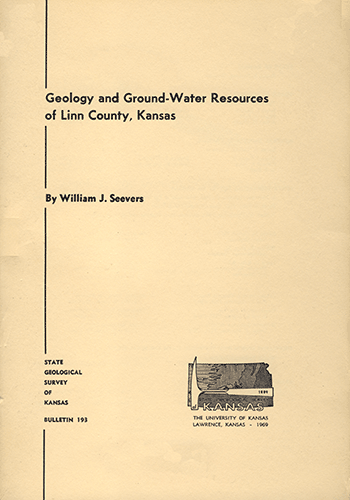Geology and Ground-water Resources of Linn County, Kansas
By William J. Seevers

Originally published in 1969 as Kansas Geological Survey Bulletin 193. This is, in general, the original text as published. The information has not been updated.
You may also wish to visit our web site on the Linn County geologic map.
Abstract
Linn County is located along the Kansas-Missouri boundary in east-central Kansas and is a nearly square area of about 605 square miles. The relief in this area is moderate, and the topography is characterized by northeast-trending cuestas that face southeast. The county is located mostly within the Marais des Cygnes River drainage basin and contains a segment of this river in its northeastern part.
Pennsylvanian rocks, Desmoinesian and Missourian Stages, are exposed in the county and have an aggregate thickness of 660 feet. The dominant lithology is shale followed by limestone, sandstone, and minor amounts of coal. Rocks in this part of Kansas are gently tilted to the northwest at about 20 feet per mile.
All but the smallest tributary stream valleys are filled to some depth with locally derived and unconsolidated materials. These materials are mainly clay and silt with several feet of medium to coarse gravel near the base. Thickness of these valley-fill deposits ranges from several feet in smaller stream valleys to 50 feet in the principal valleys.
Approximately 780 feet of Arbuckle Group (Cambrian and Ordovician), 20 feet of Devonian, 320 feet of Mississippian, and 400 feet of Pennsylvanian (Desmoinesian) rock underlie the oldest outcropping Pennsylvanian rocks in Linn County.
Small domal structures of modest relief and a number of small-scale structures related to compaction and collapse are noted at the surface. Two apparent collapse-related structures in southeastern Linn County are associated with lead and zinc mineralization.
Only very small quantities of ground water are obtained from Pennsylvanian rocks in Linn County. Yields rarely exceed 1 gallon per minute and are normally barely sufficient for domestic purposes. Limestones are the most productive aquifers, and limestones of the lower part of the Kansas City Group are the best of the bedrock aquifers.
Ground water below a depth of about 100 feet in this area is normally too highly mineralized for use. However, in areas in Missouri close to the southeast corner of Linn County, water is obtained from the Cherokee Group at depths of 400 to 600 feet. At still greater depths in this area, large quantities (150 gallons per minute) of highly mineralized water are obtained from Ordovician rocks and moderate quantities (10 gallons per minute) from Mississippian rocks.
Large quantities (30 to 100 gallons per minute) of good quality water are obtained from properly constructed and developed wells in Illinoisan and Wisconsinan valley-fill deposits, mainly from thin gravel deposits near the base.
Kansas Geological Survey, Geology
Placed on web June 8, 2009; originally published November 1969.
Comments to webadmin@kgs.ku.edu
The URL for this page is http://www.kgs.ku.edu/General/Geology/Linn/index.html